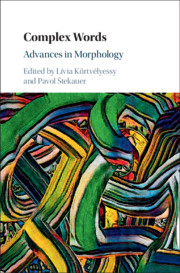Book contents
- Complex Words
- Complex Words
- Copyright page
- Dedication
- Contents
- Contributors
- Introduction: Advances in Morphology
- Part I Lexico-Semantic Aspects of Complex Words
- Part II Structure of Complex Words
- 7 Estonian Case Inflection Made Simple
- 8 Uninflectedness
- 9 Complex Exponents
- 10 Derivational Patterns in Proto-Basque Word Structure
- 11 The Complexity of Greek Verbal Morphology
- 12 Affixoids
- Part III Corpus-Based Case Studies
- Index
- References
7 - Estonian Case Inflection Made Simple
A Case Study in Word and Paradigm Morphology with Linear Discriminative Learning
from Part II - Structure of Complex Words
Published online by Cambridge University Press: 18 September 2020
- Complex Words
- Complex Words
- Copyright page
- Dedication
- Contents
- Contributors
- Introduction: Advances in Morphology
- Part I Lexico-Semantic Aspects of Complex Words
- Part II Structure of Complex Words
- 7 Estonian Case Inflection Made Simple
- 8 Uninflectedness
- 9 Complex Exponents
- 10 Derivational Patterns in Proto-Basque Word Structure
- 11 The Complexity of Greek Verbal Morphology
- 12 Affixoids
- Part III Corpus-Based Case Studies
- Index
- References
Summary
According to word and paradigm morphology (Matthews 1974, Blevins 2016), the word is the basic cognitive unit over which paradigmatic analogy operates to predict form and meaning of novel forms. Baayen et al. (2019b, 2018) introduced a computational formalization of word and paradigm morphology which makes it possible to model the production and comprehension of complex words without requiring exponents, morphemes, inflectional classes, and separate treatment of regular and irregular morphology. This computational model, Linear Discriminative Learning (LDL), makes use of simple matrix algebra to move from words’ forms to meanings (comprehension) and from words’ meanings to their forms (production). In Baayen et al. (2018), we showed that LDL makes accurate predictions for Latin verb conjugations. The present study reports results for noun declension in Estonian. Consistent with previous findings, the model’s predictions for comprehension and production are highly accurate. Importantly, the model achieves this high accuracy without being informed about stems, exponents, and inflectional classes.The speech errors produced by the model look like errors that native speakers might make. When the model is trained on incomplete paradigms, comprehension accuracy for unseen forms is hardly affected, but production accuracy decreases, reflecting the well-known asymmetry between comprehension and production.
- Type
- Chapter
- Information
- Complex WordsAdvances in Morphology, pp. 119 - 141Publisher: Cambridge University PressPrint publication year: 2020



